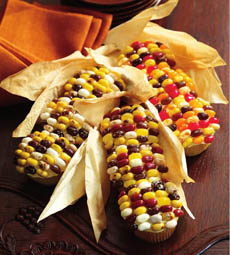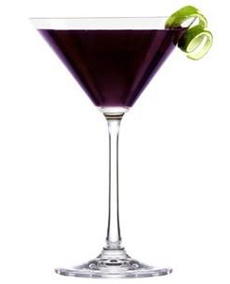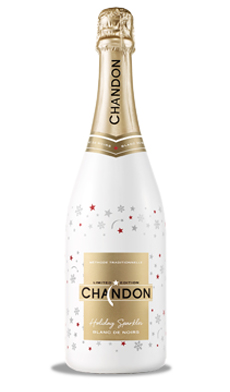
Turn cupcake decorating into family fun.
Photo courtesy Rux Martin/Houghton Mifflin
Harcourt. |
|
Preparation
1. PREHEAT the oven to 350°F. Line a cookie sheet with crumpled foil. Cut the phyllo sheet “husks” crosswise into 3-inch-wide strips, tapering both ends. Drape the stacked husks on the prepared pan, shaping them over the crumpled foil to make curves. Spray lightly with vegetable cooking spray.
2. BAKE until the phyllo is golden brown, 4 to 5 minutes. Transfer to a wire rack and allow to cool completely. (The husks can be made up to 1 day in advance and kept in an airtight container.)
3. TINT the vanilla frosting pale beige with the cocoa powder.
4. SPREAD some of the pale beige frosting on top, working with 3 cupcakes at a time. Arrange about 5 straight rows of jelly beans, side by side and close together, on each cupcake. Repeat with the remaining cupcakes, frosting, and jelly beans.
5. For each ear of corn, place 3 cupcakes end to end on a serving platter, aligning the rows of jelly beans. Arrange the phyllo husks on either side of the corn.
|
When you’re ready to eat them, the ears pull apart into individual cupcakes.
INDIAN CORN HISTORY
Every fall, Indian corn appears along with the pumpkins, a symbol of the harvest season. Also known as flint corn, these ears of multicolored kernels—blue, brown, red, white and yellow—adorn front doors and centerpieces.
Corn was domesticated some 10,000 years from teosinte, a variety of wild Mexican grass. It was brought to Europe by Christopher Columbus in the late 1400s and soon made its way to much of the rest of the globe via explorers and traders. Corn became a dietary staple for humans and livestock.
Indian corn, or flint corn, is one of the oldest varieties of corn. It’s the variety that the early colonists learned how to cultivate from Native Americans. The kernel shells are “hard as flint”, hence the name. A small amount of soft starch is surrounded by a larger amount of hard starch. This tough exterior means that the kernels shrink uniformly when drying and are dent-free and less prone to spoiling. That’s why they work so well as décor.
While it is edible, other varieties of corn evolved. In modern times, the most commonly cultivated kind of corn in America is dent corn (also called field corn), which is used primarily to feed livestock.
Dent corn gets its name from the indentation that appears on the outside of its mature kernels, a result of the hard and soft starch contained in each kernel shrinking unequally during ripening. It is also used in the manufacture of industrial products and processed foods (by some accounts, corn is contained in 75% of all grocery items). Dent corn is also used to make a wide range of non-culinary products, including cosmetics, ethanol, explosives, fabrics, paints, paper goods, and pharmaceuticals.
The type of corn typically eaten by people is sweet corn. Like dent corn, its kernels are usually yellow or white.
The United States is the world’s top producer and exporter of corn, the majority of which is grown in the Midwest, the “Corn Belt.” (Source: History.com)
|







